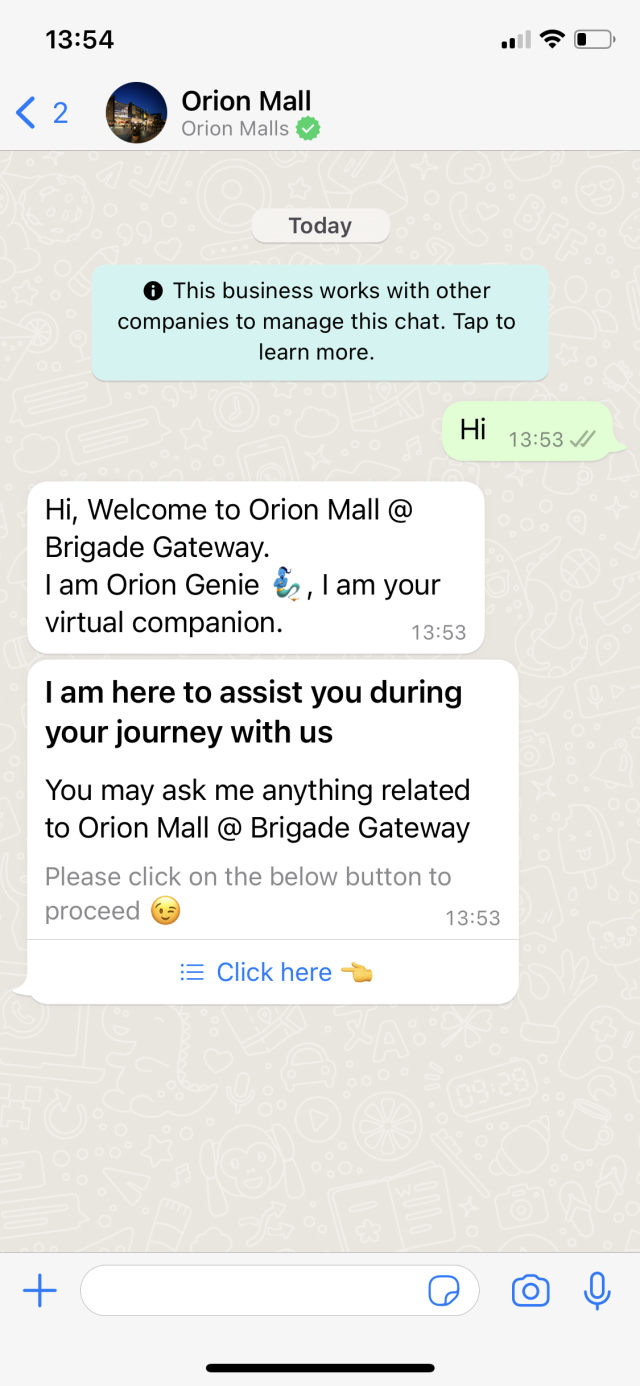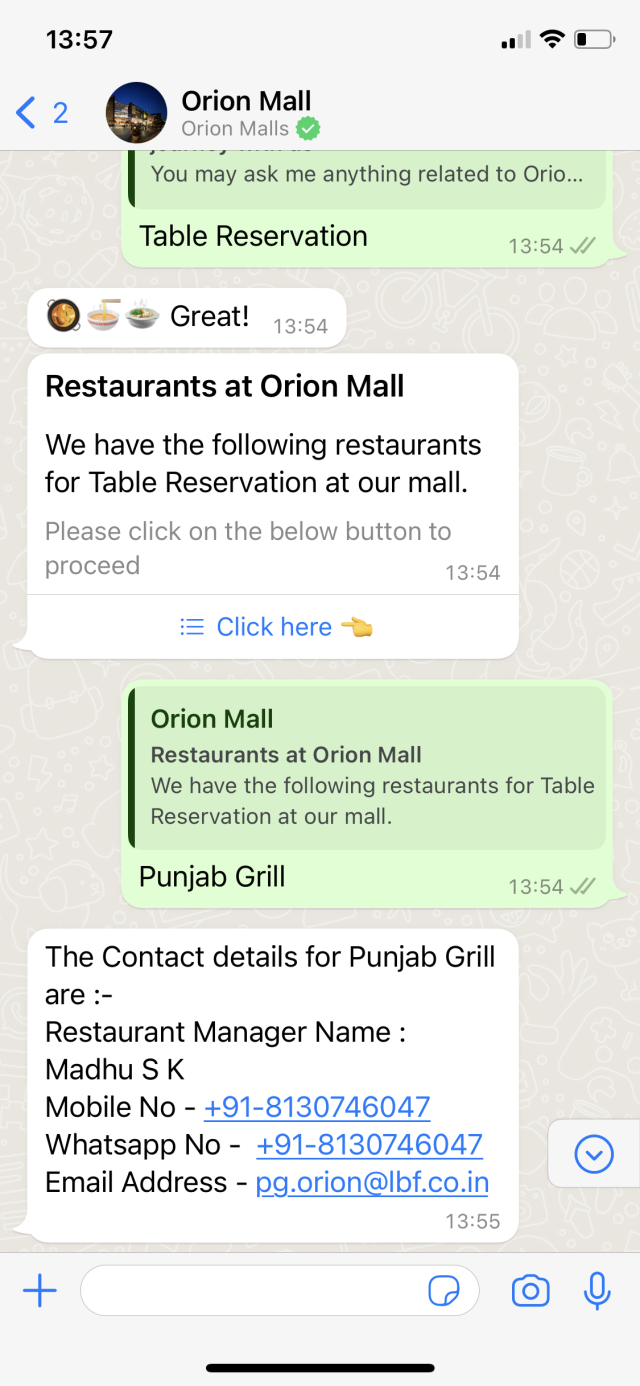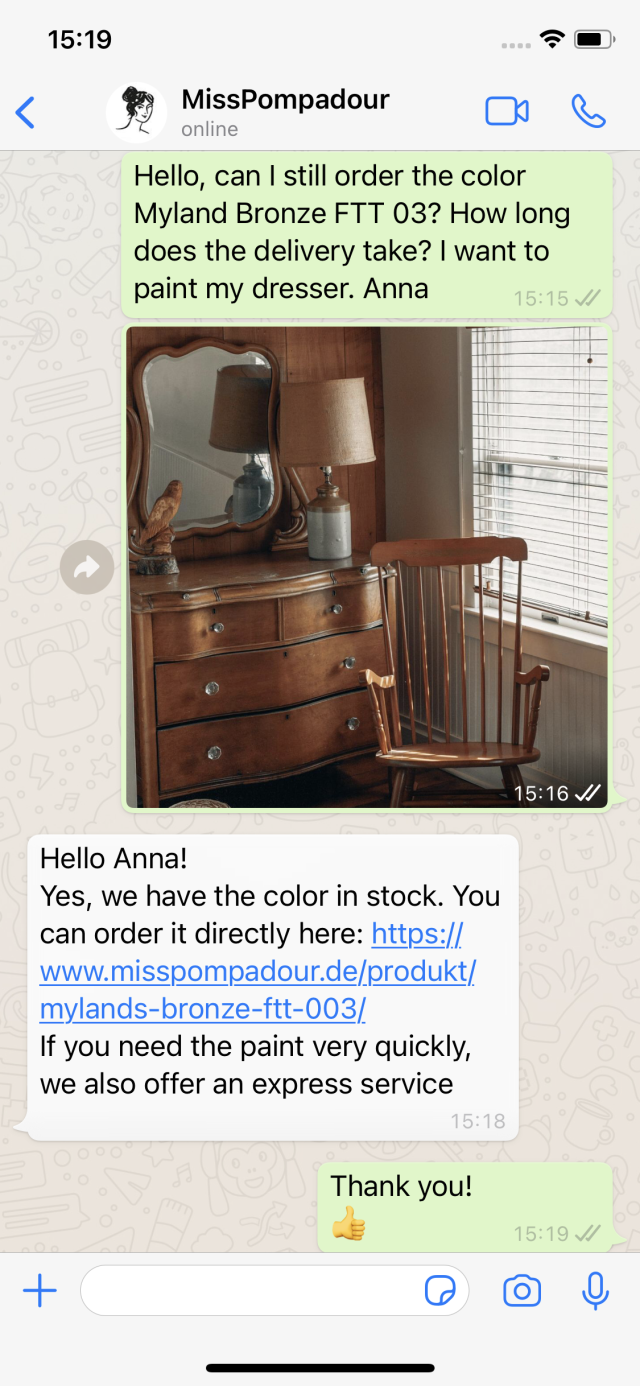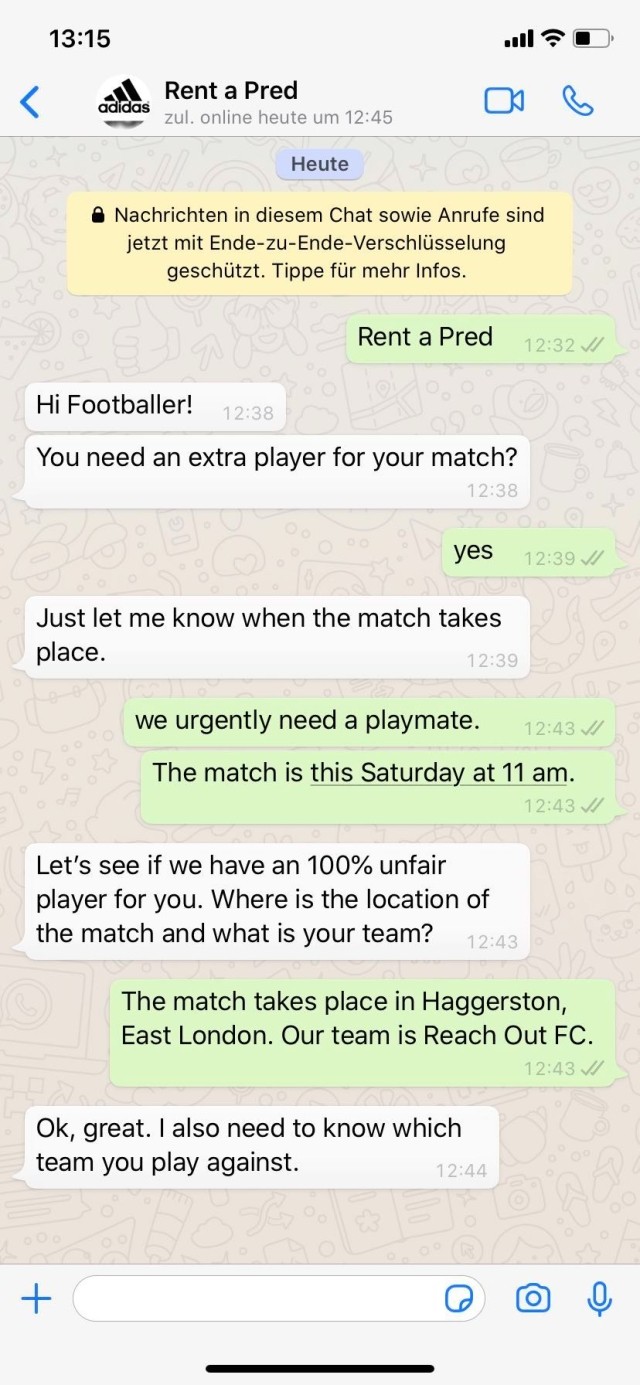In this article:
Looking to take your marketing game to the next level? Check out our guide on messaging apps for marketing! From tips on how to use them to grow your business, to examples, to advice on which app is best for your needs, we’ve got you covered.
Messaging apps for marketing? Isn't that really outdated? ❌ Wrong answer! While it's true that many companies shifted their focus to using messaging for customer service, marketing on messaging apps is back! Two megatrends are pushing this revival: conversational marketing and a new focus on the customer experience. And it also doesn't hurt that Meta has been opening up WhatsApp, Instagram Direct and Facebook Messenger for push notifications again.
In the following, we'll show you possibilities, examples, and tips for using messaging apps for marketing to grow our business.
Marketing on messaging apps is back, and more important than ever!
Marketing on messaging apps means that a company uses mobile chat-based apps, such as WhatsApp, Telegram, or Instagram Direct to get in touch with existing and potential clients.
There's been an interesting development around this use case. When messaging apps like WhatsApp really grew in popularity, almost any company started sending out marketing newsletters. However, for many messaging apps, this was never an intended scenario, and users also were receiving a lot of spam. So Meta started to shut down the feature, and companies moved from push notifications to customer service on messenger apps.
However, with the maturing of messaging channels and new guidelines around marketing campaigns, businesses are re-discovering messaging apps for marketing campaigns. And they're also becoming a lot more creative and engaging.
This goes along with a shift in user behavior on messaging apps. Telegram, WhatsApp, Facebook Messenger, and others are still important for talking to friends and families. However, people's use of messaging apps has become more diverse.
According to data from Hootsuite and We are social, some of the main reasons for using social media channels like messaging apps are:
- reading news (34.8%)
- finding content (31%)
- finding inspiration for things to buy (27,6%)
- finding products to purchase (26,6%)
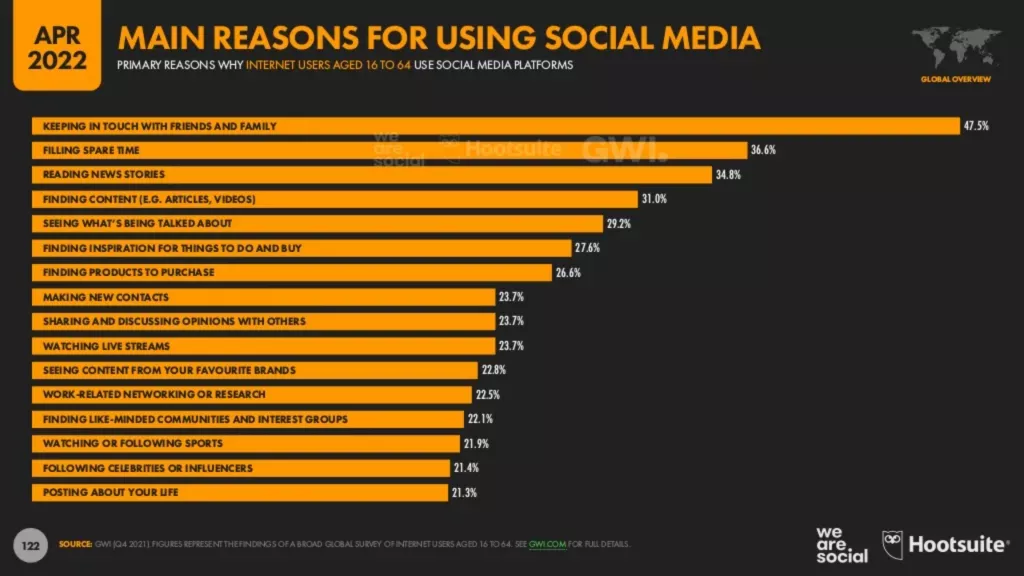
This shows: users are increasingly utilizing messaging apps to find information, inspiration, and shopping opportunities. That's what makes messaging channels such an interesting marketing tool. In fact, there are two ways to use messaging for marketing: through push and pull communication.
Messaging apps for marketing: push and pull communication
Messaging can be roughly divided into two types of communication: push and pull, even though, there are of course many shades in between, and you can also combine push and pull messaging.
A) Push communication: you reach out proactively to customers
Push messages are initiated by a company. Traditionally, this used to be a one-way communication. So, companies send out a message, users receive it, but don't answer. Your typical ads and call to actions, such as "buy this product!", or "call us back for the best deals" are considered to be one-way push communication. In the messaging world, push communication normally happens through newsletters or marketing notifications.
- usce cases: content marketing and CRM, news and updates, deals, ads
- recommended messaging apps: Telegram Messenger, Apple Mesages for Business, WhatsApp (broadcasting lists)
When using messaging push notifications, the most important requirement is: you need a prior opt-in from your users (that's in line with your country's data protection laws), very similar to what you know from e-mail newsletters.
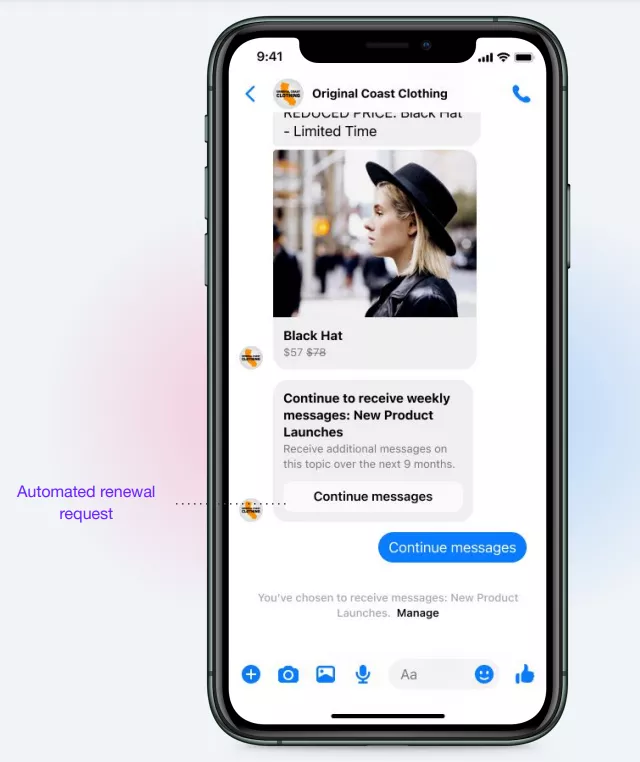
🚀 Webinar: How to get the most out of WhatsApp marketing (notifications)
B) Pull communication: conversation as a marketing tool
Pull communication focuses on an exchange between users and companies in order to increase customer loyalty, to position yourself as a brand, but also to learn more about customer expectations.
The important difference to push communication is: users initiate the conversation with your company. This can make it more difficult for companies to get in touch with their customers, but it's worth the effort, because the results are better.
- Implementation: position yourself as expert and helper for your target group, and offer additional value when prompted
- Recommended messaging apps: WhatsApp, Facebook Messenger, Apple Messages for Business, Instagram Direct
The most important requirement for pull communication for marketing on messaging apps: it requires an external impulse (ad on a flyer, an Instagram ad, audio commercials, QR code, etc.) that users can follow to contact you. Only then, after a user initiates contact, do you start chatting with them.

It's exactly this type of marketing on messaging apps that's becoming more interesting for companies, due to two megatrends: conversational marketing and the growing importance of an immersive customer experience (CX).
Conversational marketing
Conversational marketing focuses on the conversational aspect of marketing. So, instead of the one-way push communication, the dialogue and direct interaction between customers and businesses becomes more relevant.
It's not a completely new form of marketing, but rather one that's been neglected by marketers, explains Matt Ramerman, President at Sinch for Marketing.
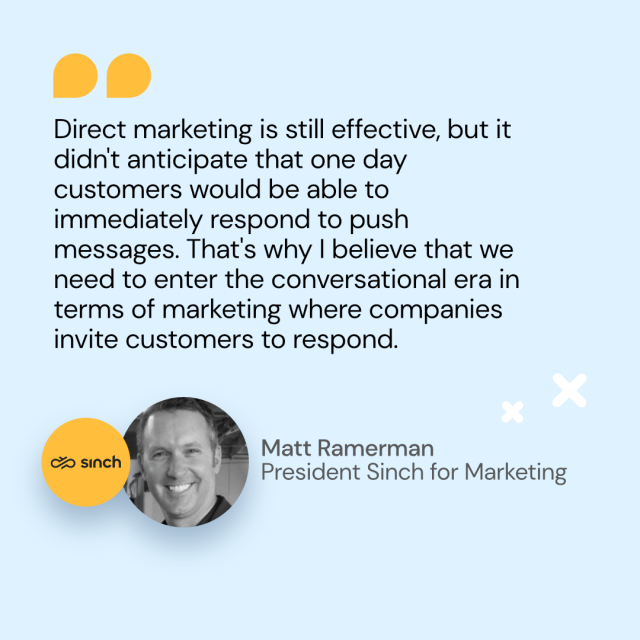
Conversational marketing is not the same as conversational commerce. In conversational commerce, the goal is to use the dialogue between brands and customers to push sales, conversational marketing is more focused on brand positioning, visibility, recognition, and attention.
By using conversations to achieve these goals, brands start a dialogue with their customers. This leaves room for important feedback while allowing customers to build a more personal relationship with a company. And that's exactly what customers expect from a business these days.
89% of consumers want conversations on messaging apps!
The strength of conversational marketing is that you can offer these conversations and build stronger relationships with your clients. Conversational campaigns therefore always position your brand as "friend and helper", and as an equal partner.
- Conversational campaigns offer true additional value for the user.
- The additional value is not just the product, but also the thought leadership of the brand.
- Companies talk to customers on messaging chats like a friend.
- It creates a direct relationship between brand and customer.
- Campaigns can become more engaging by using the multimedia capabilities of messaging channels.
- Conversational campaigns allow you to re-use content that you've already created for other platforms.
In many ways, conversational marketing can be considered the evolution of direct marketing, as it combines push and pull marketing techniques to build stronger relationships and more engaging interactions with customers.
And brands shouldn't just focus on conversational marketing because it's a trend. They should because it's what users are looking for in their customer experience!
The customer experience (CX)
The pandemic years have drastically changed how we communicate. Our interactions have become more digital, not only on a personal level, but also when we're talking to businesses. At the same time, this has changed the expectations towards the consumer-business dialogue.
Consumers are now expecting the same rich experience they know from direct interactions on digital channels. Messaging apps are the perfect way to deliver that experience!
- Customers can get a tracking update for their packages on WhatsApp. But why not use the opportunity to already offer help in case of a return? Nine out of ten clients would love that!
- It's a great start if banks send a warning about a possibly corrupted credit card on a messaging app. But why not also give the customer options to block their card or register for a new one?
- It's very helpful when companies send shopping ideas via chat. However, why not take it one step further and guide the customer through the entire purchasing process?
Especially when you add conversational AI chatbots to the mix, you can create an engaging and immersive CX.
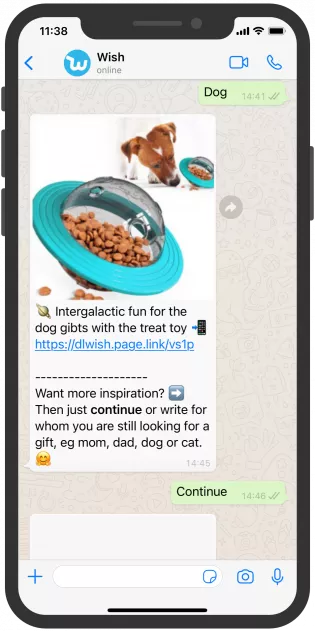
As inherently conversational channels, messaging apps are the perfect fit for conversational marketing campaigns, and they allow you to explore push and pull communication in new and innovative ways.
Push communication and messaging
When customers agree via opt-in to receive messaging updates, WhatsApp, iMessage, Facebook Messenger and others are the perfect channel for push communication.
Send relevant information
From special deals to important updates to appointment reminders: messaging apps are ideal for sending important information. Unlike with e-mail notifications, users see your messages right away on their lock screen.
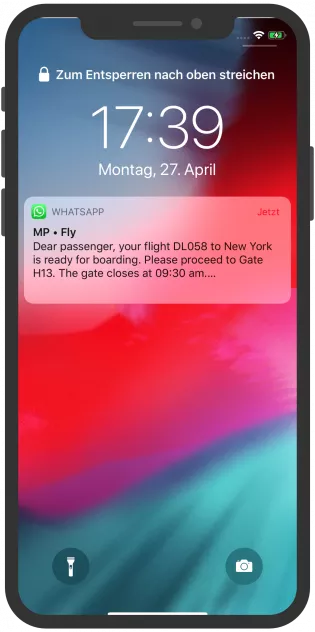
The sports brand Women's Best also works with push notifications. In their case, they send customized iMessages, such as a special birthday deal, to their customers. This is a clever way to get a user's full attention and trigger sales.
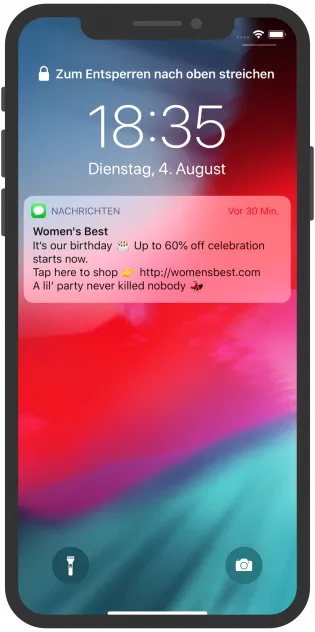
Marketing notifications
Marketing notifications, newsletters, and broadcasts are some of the most popular forms of push marketing on messaging apps. Especially since Meta has been re-instating its marketing notifications, first on WhatsApp, and recently on Facebook Messenger, this has become very convenient for businesses.
Streaming giant Netflix, for example, is sending out WhatsApp push notifications to promote the latest shows that you can binge.

Marketing campaigns are not limited to WhatsApp. You can basically use any messaging app. Just make sure it's a channel your target group uses! The fashion brand Chic Me, for example, uses Facebook Messenger to send out regular newsletters with deals to interested subscribers.
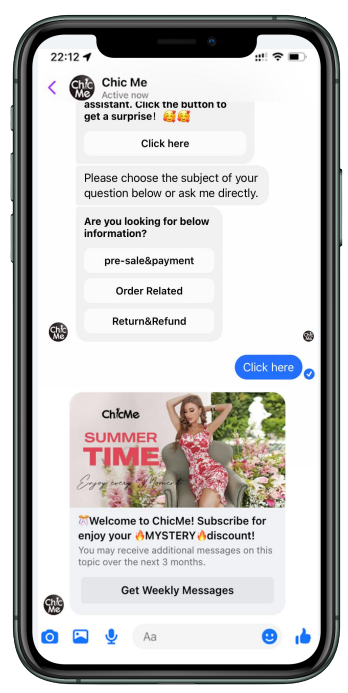
There are several options to use messaging channels to send out marketing notifications. Aside from Meta's family of apps, Apple Messages for Business, Telegram, Notify, or Viber can be great choices, depending on your customers' preferred channels.
And as a business, you're guaranteed to get the users' full attention. No algorithms and no spam folders stop your message from getting through.
Gamification for more engagement
Push communication can also be used to increase engagement with your brand. Especially games can be a great tool for that. After all, who doesn't like to play games?!
The Healthy Indian Project, a heatlh initiative from the Indian government, for example, uses the quizz format to engage and educate users about important health topics. The chatbot RAKSHA quizzes users on their knowledge about different health topics, and then provides useful information for further reading.
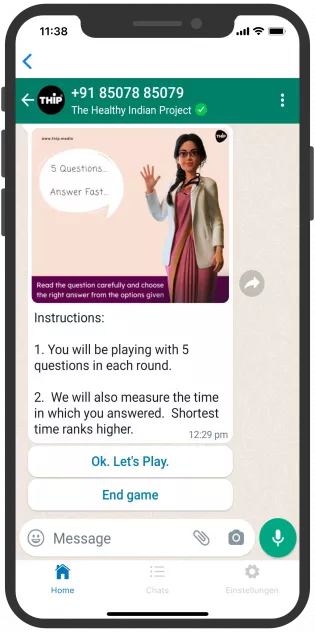
Lead generation with chatbots
Gaining new leads for test rides, teeth cleanings, or events on messaging apps? No problem! Especially when combining messaging apps with chatbots, lead generation can be very successful.
The Orion Mall in Bangalore, for example, wanted to attract more visitors to their shopping mall. They implemented both, a regular newsletter and a chatbot on WhatsApp where users get information about ongoing events or can ask the chatbot "Genie" about them.
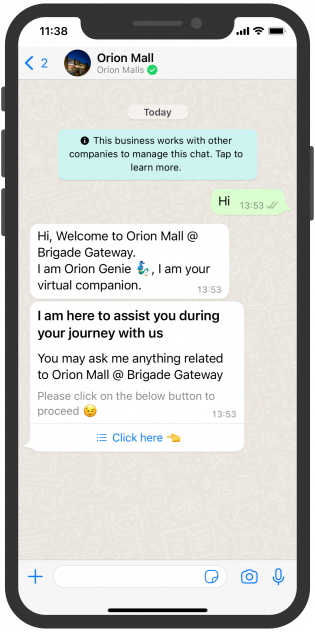
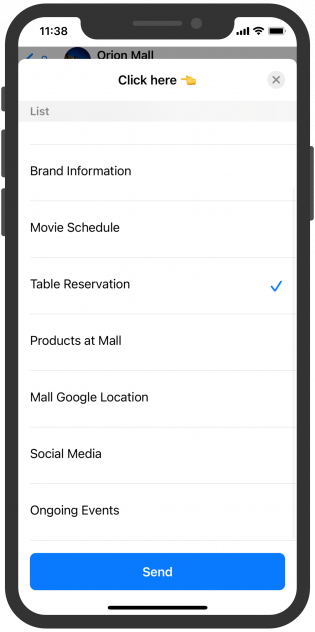
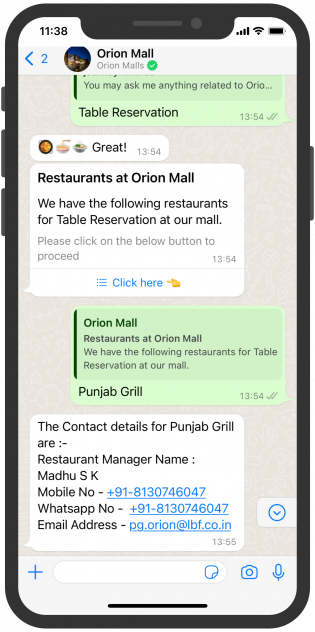
As a result, the mall was able to increase foot traffic to the mall, says Rahul Malhotra, Head of Marketing at Brigade Group (Orion Malls). The key to their success was to combine push and pull marketing.
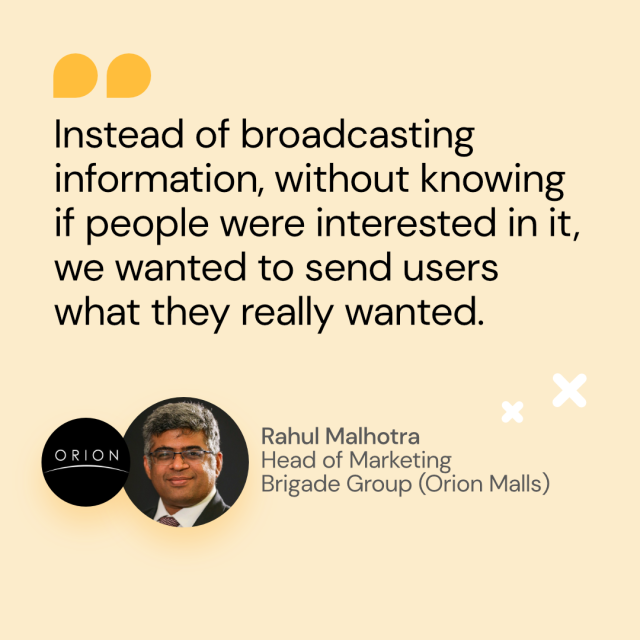
Pull communication and messaging
As mentioned before, pull communication is also very promising when it comes to customer communication. It might not seem as useful for companies if you have to wait for customers to reach out to you first. However, if a company manages to make their marketing engaging enough for people to reach out, you'll get more qualified leads out of your campaigns because customers WANT to talk to you about your offers.
The challenge is, of course, to offer users a great experience and additional value to get them curious enough to reach out to you. The following examples are a great inspiration!
stylink positions itself in new market with newsletters on Apple Messages for Business
When the German influencer platform stylink expanded to the US, they were looking for an innovative way to position their brand in a new market. As they had used WhatsApp marketing successfully in Europe, they decided to run marketing campaigns on Apple Messages for Business, a much more popular channel in the US than WhatsApp.
By sending out newsletters on iMessage, the brand was quickly able to connect with new users, and position their brand. Unlike typical push newsletters, however, stylink promoted the newsletter on other channels, and only sent it out to users who expressed interest in receiving it. This approach was a huge success!
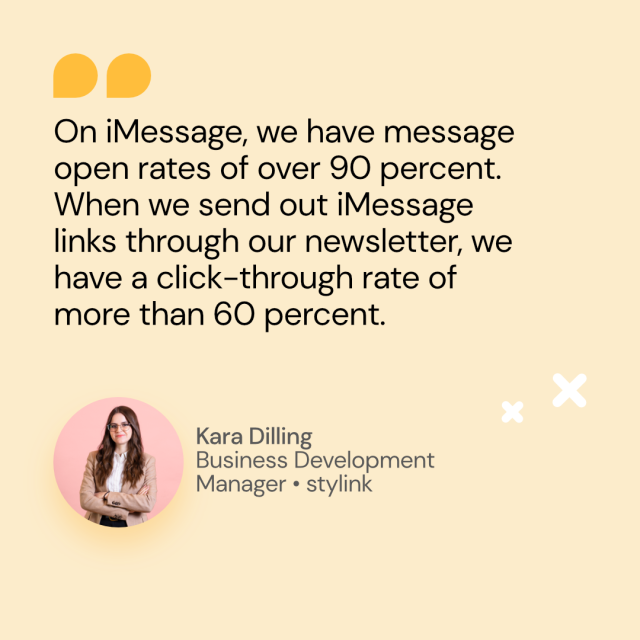
As a result, stylink was able to double their user base in the US, which shows how successful messaging marketing campaigns can be to gain new customers, and grow your brand.
Promote new products
Pull marketing can be a very powerful alternative to social media or e-mail ads to promote new products. Instead of the usual "buy this!", conversational marketing on messaging apps is able to create an even bigger buzz around a launch.
French luxury brand Dior, for example, created a WhatsApp influencer campaign around a new lipstick. They worked with the influencer Jisoo to make this happen. First, Jisoo posted a story on Instagram to guide her followers to a WhatsApp channel. Users that subscribed to the new channel, received behind the scene clips about Jisoo's work as a brand ambassador, as well as en exclusive early bird link to purchase the lipstick.
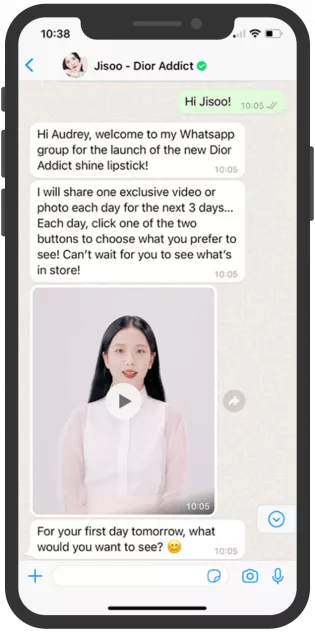
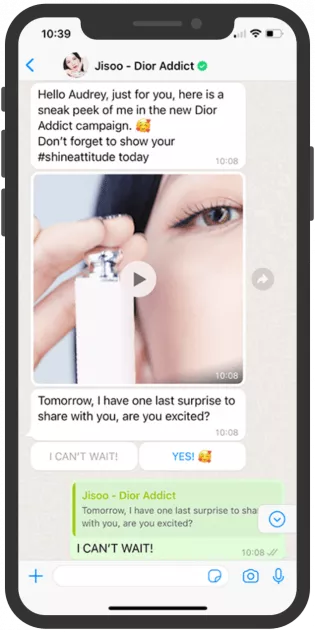
The campaign not only generated a lot of attention, but also increased sales.
Engagement campaigns via messaging
As the Dior example shows, conversational marketing on messaging apps is also great for increasing engagement.
The Indian e-commerce brand Tata CLIQ, for instance, uses the WhatsApp Business Platform to send personalized messages and offers to their customers. One of their goals is to increase click-through rates.
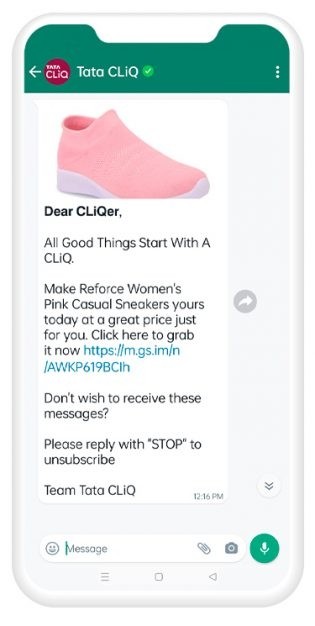
These personalized campaigns lead to a lot more engagement for Tata CLiQ than other campaigns. Their click-through rates average 57%.
Gain new customers
Gaining new customers through pull marketing can also be very successful. If a person contacts you to sign up for a subscription or buy something because they saw your campaign, chances of them converting are much higher.
The online retailer MissPompadour, for example, sells high-quality DIY paint. Customers typically discover the business through their visual social media channels, and then reach out with questions on WhatsApp.
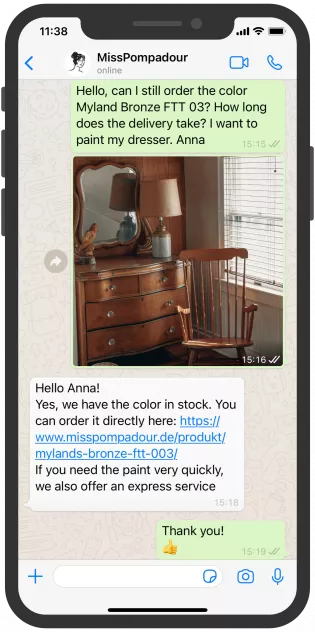
This method has proved highly successful for MissPompadour. Nine out of ten chats result in a sale!
Click-to-chat ads
Click-to-chat ads can be a great supportive tool for pull marketing, as these ads guide users directly into your chat. These ads are currently supported by Facebook and Instagram, and you can use them to lead users to your messaging channels.
All you have to do is include a "send message" button into your ad. Users that click on it, end up in a messaging channel. You can even set it up for an automated routing into the users' preferred channel.
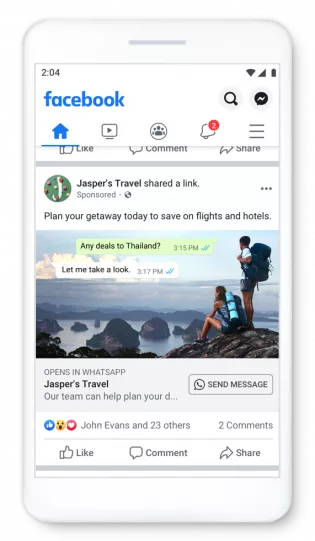
Conversational AI chatbots
Conversational messaging and conversational chatbots go hand in hand. This type of chatbot uses technologies such as artificial intelligence, natural language processing, and machine learning to have more engaging interactions with customers.
The Brazilian food delivery brand, iFood, uses an AI-based bot that chats with customers, and helps them buy gift cards.
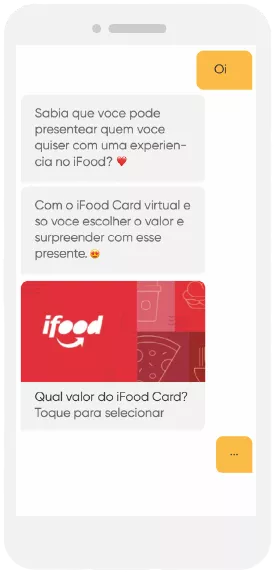
With the chatbot, iFood has been able to sell more gift cards and improve their customer satisfaction score.
Examples of marketing campaigns on messaging apps
You can use messaging apps both, for one-time campaigns for special occasions like Christmas or Diwali, and for regular customer communication. Either way, the conversation with your customer is going to be the focus. Get inspired by some brands that are already using conversational marketing and messaging apps successfully.
Adidas promotes a sneaker via WhatsApp
In the UK, sports brand adidas launched a very successful WhatsApp campaign to promote its new Predator20 Mutator gear. Whenever a local club was in desperate need of a substitution player, they could text adidas on WhatsApp and require a replacement.
In a first step, a chatbot would ask users some general questions about the location and the time of the game, and would then alert the team if they were receiving a substiution player. Funny twist: the players for the amateur clubs were top athletes, like Kaká.
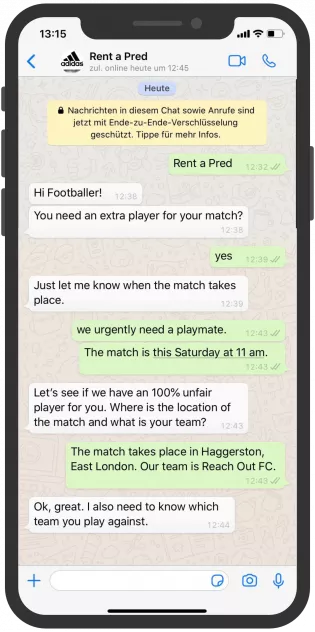
These "100% unfair" subs would then show up fully dressed in an adidas Predator 20 Mutator outfit. The campaign was extremely successful and generated great buzz for adidas' new line.
Nivea sends thoughtful content for mother's day
For mother's day, Nivea Switzerland came out with a special pull marketing campaign. The beauty brand invited users to contact them in order to receive inspirational content like videos, images, or messages that they could then forward to their mothers.
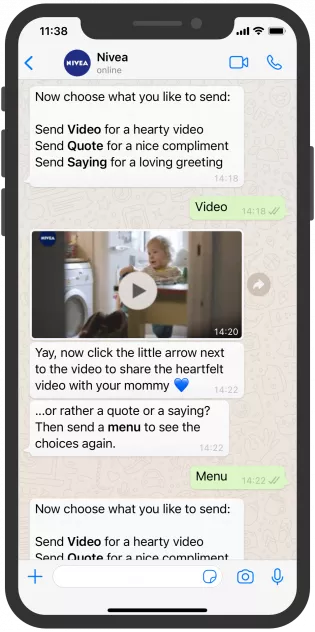
This is a great example of how you can pull in your audience by delivering valuable content for them.
Growing the user base and content strategy
🚀 Growing the user base
Marketing through messaging apps is only successful if it reaches enough people. However, customers can't search for businesses on every messaging app, which makes it harder for them to reach out to you. Even if it's possible, it's not a given that users do. That's why it's important to use external platforms like social networks, flyers, or even business cards to promote your messaging channels.
📖 Content strategy
For a campaign to be successful, you also need to understand what content works for messaging apps. Because: every platform deserves its own, dedicated content.
We therefore recommend finding out what channels your target group uses. The advantage of messaging apps: they're by far the most popular communication channel right now, so it won't be hard for you to figure out the best messaging app and strategy for your target group.
Best tools for crafting engaging marketing campaigns for messenger apps
Messenger apps are vibrant communication channels. And just like users have changed their behavior, brands should adapt their approach.
Messaging apps still offer many opportunities for direct marketing and customer service. However, messaging apps are first and foremost conversational channels, and you'll have the most success with your campaigns if you use them as such.
Regardless of your use case, though, make sure you get started with a messaging solution that allows you to use the full spectrum of messaging, from sending out promotional messages to integrating chatbots to guaranteeing data privacy.
Sinch Engage offers you all of that, and even more. For example, you can use multiple messaging channels at once, and manage them all from one central inbox. There's also no need for special IT infrastructure or coding skills, as it's a ready-to-go solution, and you can get started right away.
🚀 Start growing your business with messaging apps!

